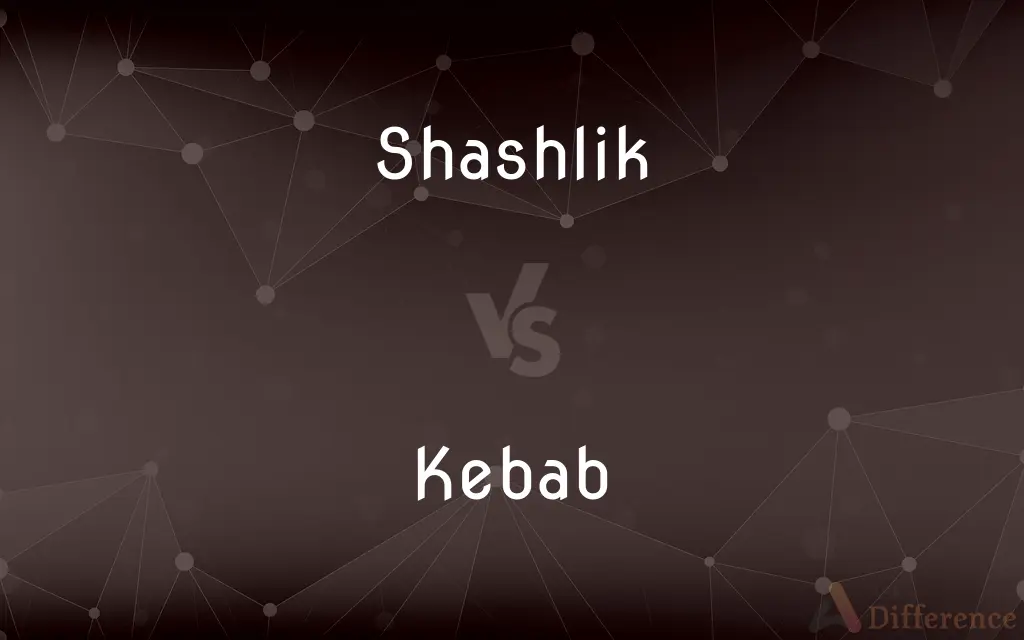Shashlik vs. Kebab — What's the Difference?
By Fiza Rafique & Urooj Arif — Updated on April 1, 2024
Shashlik is a specific type of kebab, often marinated and grilled, while kebabs encompass a wider variety of skewered meats.

Difference Between Shashlik and Kebab
Table of Contents
ADVERTISEMENT
Key Differences
Shashlik originates from Eastern Europe and Central Asia, traditionally made with marinated meat, skewered and grilled. It is known for its specific marination process, which often includes vinegar, herbs, and sometimes yogurt, giving it a distinctive flavor and tenderness. Kebabs, on the other hand, have a broader definition, originating from Middle Eastern cuisine and including a wide variety of skewered meats, vegetables, and even seafood. They can be prepared in numerous ways, including grilling, roasting, or frying, and with a variety of seasonings, making them incredibly diverse in taste and presentation.
While shashlik is typically prepared with larger chunks of meat, allowing for a longer marination process and a tender inside with a charred exterior, kebabs can be made from ground meat or smaller pieces, which influences the cooking time and method. This difference in preparation not only affects the texture and flavor but also the traditional side dishes and condiments that accompany them.
In terms of ingredients, shashlik often uses pork, lamb, or beef, marinated in a mixture of acidic and aromatic components. Kebabs, however, can be made from a wider range of meats, including chicken, fish, and even vegetarian options like paneer or tofu. The choice of meat and marinade for kebabs is influenced by regional preferences and dietary restrictions.
Shashlik is commonly associated with outdoor cooking and social gatherings in its regions of origin, where it is not just a dish but a part of the cultural heritage. Kebabs, while also popular in social settings, are more widely recognized as street food across many countries, easily adapted to fast-food contexts and served in a variety of formats, including wraps and plates.
The presentation of shashlik and kebabs also varies, with shashlik often served straight from the skewer onto a plate, accompanied by vegetables and sometimes bread. Kebabs can be found in numerous serving styles, from skewers to being chopped and served on plates with rice or salads, or wrapped in flatbreads with sauces and vegetables.
ADVERTISEMENT
Comparison Chart
Origin
Eastern Europe and Central Asia
Middle East
Meat
Usually pork, lamb, or beef
Varied, including chicken, beef, lamb, fish
Preparation
Marinated, skewered, grilled
Grilled, roasted, fried; skewered or ground
Seasoning
Specific marination process
Wide variety, including spices and herbs
Serving Tradition
Often in social gatherings, with vegetables
Street food, versatile in presentation
Compare with Definitions
Shashlik
Often marinated with vinegar, herbs, and spices for enhanced flavor.
The shashlik had been marinating overnight, absorbing all the flavors.
Kebab
A broad category of meat dishes originating from the Middle East, often skewered and grilled.
We ordered chicken kebabs from the local Middle Eastern restaurant.
Shashlik
A type of skewered and grilled meat originating from Eastern Europe and Central Asia.
We enjoyed homemade shashlik at the outdoor gathering.
Kebab
Can include a variety of meats and preparation methods.
The kebabs were made from ground beef and grilled to perfection.
Shashlik
Served straight from the skewer, often with vegetables and bread.
Shashlik was served with fresh onions and rye bread on the side.
Kebab
Known for their diverse seasonings, including a mix of spices and herbs.
The kebabs had a unique blend of spices, setting them apart.
Shashlik
Traditionally cooked over an open flame for a charred exterior.
The shashlik was perfectly charred, thanks to the charcoal grill.
Kebab
Served in various ways, including on skewers, in wraps, or on plates.
The street vendor served the kebabs wrapped in a flatbread with sauce.
Shashlik
Usually made with larger cuts of meat like pork, lamb, or beef.
They prepared lamb shashlik for the barbecue.
Kebab
Popular as street food and adaptable to many dietary preferences.
Vegetarian kebabs made with paneer were a great alternative for vegetarians.
Shashlik
Shashlik, or shashlick (Russian: шашлык shashlyk), is a dish of skewered and grilled cubes of meat, similar to or synonymous with shish kebab. It is known traditionally by various other names in the Caucasus, Eastern Europe and Central Asia, and from the 19th century became popular as shashlik across much of the Russian Empire and nowadays in the Russian Federation and former Soviet republics.
Kebab
Kebabs are various cooked meat dishes with their origins in Middle Eastern cuisine. Numerous variants are popular around the world.
Shashlik
A dish consisting of marinated cubes of meat, such as lamb, grilled or roasted on a spit, often with slices of various vegetables; shish kebab.
Kebab
A dish of pieces of meat, fish, or vegetables roasted or grilled on a skewer or spit.
Shashlik
A form of shish kebab, originally made of marinated lamb meat.
Kebab
Shish kebab.
Kebab
(British) A dish of pieces of meat, fish, or vegetables roasted on a skewer or spit, especially a doner kebab.
Kebab
(AU) A hand-held dish consisting of pieces of meat roasted on an upright skewer mixed with fresh vegetables and sauces and rolled up in a round piece of unleavened bread.
Kebab
(US) A shish kebab or any other food on a skewer.
Kebab
A restaurant that sells kebabs
Let's go to the kebab after the club.
Kebab
(chemistry) The outward growing portions of a shish kebab structure.
Kebab
A Muslim, usually of southern European, Middle Eastern, or North African descent.
Kebab
The vulva.
Kebab
(GUI) menu icon of three vertical dots
Kebab
(transitive) To roast in the style of a kebab
Kebab
To stab or skewer
Kebab
See kabab and kabob.
Kebab
Cubes of meat marinated and cooked on a skewer usually with vegetables
Common Curiosities
How does shashlik differ from other kebabs?
Shashlik is specifically marinated and often uses larger cuts of meat, while kebabs can vary widely in ingredients and preparation methods.
Can kebabs be vegetarian?
Yes, kebabs can be made with vegetarian options like paneer, tofu, or vegetables.
Is shashlik considered a healthy dish?
Shashlik can be part of a healthy diet if prepared with lean meats and served with vegetables, though its healthiness depends on the marination and cooking methods.
What meats are commonly used for shashlik?
Pork, lamb, and beef are the most common meats used for making shashlik.
How are kebabs traditionally served?
Kebabs can be served on skewers, in wraps, or on plates with various accompaniments like rice, salads, or flatbreads.
Are kebabs a fast food?
Kebabs are versatile and can range from street food and fast food options to gourmet preparations.
What is shashlik?
Shashlik is a type of kebab made from marinated meat, skewered and grilled, originating from Eastern Europe and Central Asia.
What's the best way to marinate shashlik?
A combination of vinegar, herbs, spices, and sometimes yogurt is used for marinating shashlik, allowing the meat to marinate for several hours or overnight.
How important is the marination time for shashlik?
Marination time is crucial for shashlik, as it allows the meat to absorb flavors and become tender.
What distinguishes shashlik's flavor?
The distinctive flavor of shashlik comes from its marination process, incorporating acidic and aromatic components.
What spices are commonly used in kebabs?
Spices like cumin, coriander, paprika, and turmeric are common in kebabs, but the mix can vary widely by region.
Can shashlik be made with chicken?
While less traditional, shashlik can be made with chicken, marinated and grilled in a similar manner.
Is there a vegetarian version of shashlik?
Though not traditional, vegetarian versions of shashlik can be made using vegetables or plant-based proteins.
Can shashlik be cooked indoors?
Yes, shashlik can be cooked on a grill pan or in an oven, though it traditionally benefits from the smoky flavor of outdoor grilling.
Share Your Discovery

Previous Comparison
Slender vs. Narrow
Next Comparison
Baryte vs. BarytaAuthor Spotlight
Written by
Fiza RafiqueFiza Rafique is a skilled content writer at AskDifference.com, where she meticulously refines and enhances written pieces. Drawing from her vast editorial expertise, Fiza ensures clarity, accuracy, and precision in every article. Passionate about language, she continually seeks to elevate the quality of content for readers worldwide.
Co-written by
Urooj ArifUrooj is a skilled content writer at Ask Difference, known for her exceptional ability to simplify complex topics into engaging and informative content. With a passion for research and a flair for clear, concise writing, she consistently delivers articles that resonate with our diverse audience.















































